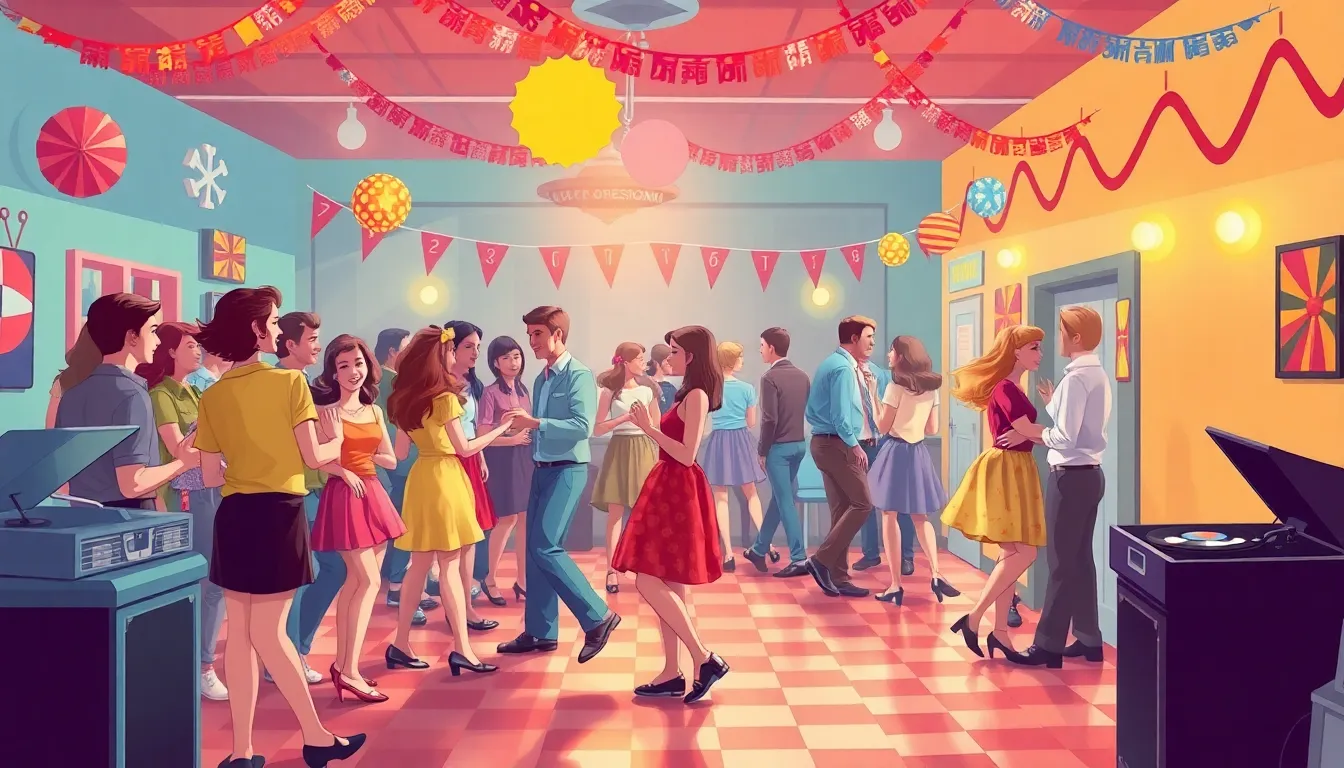Table of Contents
ToggleThe 1950s were a wild ride of sock hops, rock ‘n’ roll, and a dash of rebellion that defined a generation. This was an era when the world was tuning in to television and teenagers were finally breaking free from the shackles of post-war conservatism. From poodle skirts to greaser hairstyles, the fashion was as bold as the music that blasted from radios, setting the stage for a cultural revolution.
Overview of 50s Pop Culture
The 1950s displayed a dynamic cultural landscape, profoundly shaping modern society. Music played a key role during this decade, with rock ‘n’ roll emerging as a defining genre. Artists like Elvis Presley and Chuck Berry captivated audiences, blending rhythm and blues with energetic performances.
Teenagers became central figures, embracing newfound freedoms and pushing against societal norms. Sock hops, held in school gyms, epitomized youthful exuberance and creativity. These dance events led to the growth of a vibrant youth culture that valued expression and connection.
Fashion trends reflected this spirit of rebellion. Poodle skirts and leather jackets became symbols of individuality, marking a departure from traditional attire. Young people sought to define themselves through style, often emulating their favorite stars.
Television’s rise transformed entertainment, bringing iconic shows into American homes. Programs like “I Love Lucy” and “The Ed Sullivan Show” shaped popular humor and family dynamics. These shows showcased diverse talents and paved the way for future television programming.
Cinematic achievements also flourished in the 50s. Hollywood produced memorable films like “Rebel Without a Cause” and “West Side Story.” These movies explored themes of youth disillusionment and social change, resonating deeply with audiences.
Comics and literature provided additional avenues for cultural expression. Comic books gained popularity, introducing iconic characters such as Superman and Batman. This literary explosion captured imaginations and reflected contemporary social issues.
Overall, 50s pop culture represented a significant shift towards modernity, embodied by music, fashion, television, and film. The decade set the foundation for subsequent youth movements, influencing generations to come.
Music of the 50s

The music of the 1950s embodies a transformative era that shaped American youth culture. Rock ‘n’ roll emerged as the defining genre, igniting a cultural revolution.
Rock and Roll Revolution
Rock ‘n’ roll revolutionized popular music in the 50s. Combining rhythm and blues with country sounds, it appealed to a diverse audience. The genre offered a distinct break from traditional forms, resonating with teenagers eager for change. Dance halls filled with energetic crowds during sock hops, creating memorable experiences. This new sound not only provided an outlet for expression but also symbolized a shift toward freedom and rebellion in youth culture.
Iconic Artists and Bands
Many iconic artists and bands defined the decade. Elvis Presley emerged as the “King of Rock and Roll,” captivating audiences with his dynamic performances. Chuck Berry brought a unique style with hits like “Johnny B. Goode.” Buddy Holly showcased innovative songcraft, influencing countless musicians. Female artists like Little Richard and Brenda Lee made significant impacts on the music scene as well. These pioneers shaped the cultural landscape, leaving a legacy that continues to resonate today.
Movies and Television in the 50s
Movies and television in the 1950s reflected the dynamic cultural landscape of the era, shaping societal attitudes and providing entertainment that resonated with audiences.
Classic Films of the Era
Classic films captured the spirit and challenges of the decade. “Rebel Without a Cause,” starring James Dean, portrayed youth disillusionment and familial conflict. “West Side Story,” a musical adaptation of Romeo and Juliet, showcased the struggles between rival youth gangs. Productions like “The Ten Commandments” offered grand spectacle and historical narratives, appealing to a wide audience. Audiences flocked to theaters, eager for stories that mirrored their lives. Icons such as Marilyn Monroe and Doris Day emerged, becoming symbols of beauty and charm. These films established enduring cultural references, setting the stage for future cinematic discussions.
Impact of Television on Society
Television emerged as a dominant force in the 1950s, dramatically transforming everyday life. Shows like “I Love Lucy” captured the attention of millions with humor and relatable family dynamics. “The Ed Sullivan Show” introduced musical acts and comedy, influencing popular culture. Families gathered around their televisions, creating shared experiences that bridged generational gaps. Advertising capitalized on this trend by targeting audiences through innovative marketing. Television also influenced social norms, showcasing a vision of idealized American life. As a result, it fostered a sense of community while simultaneously shaping perceptions of race, gender, and family roles.
Fashion Trends of the 50s
Fashion in the 1950s reflected the vibrant youth culture and the rebellion that defined the decade. Styles featured bold silhouettes and eye-catching designs that appealed to teenagers discovering their identity.
The Rise of Youth Culture
The emergence of youth culture marked a significant shift in fashion trends during the 1950s. Teenagers sought styles representing their newfound freedoms and aspirations. Styles like poodle skirts and saddle shoes became popular among young girls, showcasing a playful approach to fashion. Boys embraced greaser looks characterized by leather jackets and pompadour hairstyles. This focus on youth led to an explosion of colorful clothing and creative accessories, as teenagers wished to express individuality and embrace social dynamism.
Key Fashion Icons
Several fashion icons emerged in the 1950s, influencing trends and setting standards for style. Audrey Hepburn, with her chic and elegant approach, inspired many women with her iconic looks from films like “Breakfast at Tiffany’s.” James Dean personified the rebellious spirit of the young male demographic through his casual and rugged outfits. Marilyn Monroe epitomized glamour with her figure-hugging dresses and bold makeup. These influential figures helped establish a cultural template that blended sophistication with youthful exuberance, making lasting impressions on fashion history.
Literature and Art in the 50s
The 1950s witnessed a rich evolution in literature and art, reflecting the era’s societal changes and cultural dynamism.
Influential Writers and Their Works
Notable authors like J.D. Salinger gained fame for their candid depictions of youth and alienation. Salinger’s “The Catcher in the Rye” provided a voice for the disenchanted teenager. Ray Bradbury, through works like “Fahrenheit 451,” addressed themes of censorship and conformity in an increasingly industrialized society. Additionally, poets such as Allen Ginsberg emerged, articulating the struggles of the Beat Generation. Ginsberg’s “Howl” challenged conventional norms and inspired new literary movements. These writers sparked discussions around identity and societal norms, making significant contributions to the literary landscape.
Changes in Artistic Expression
Art in the 1950s evolved significantly, moving towards abstract expressionism. Artists like Jackson Pollock introduced new techniques that emphasized spontaneity. Pollock’s drip paintings became iconic, reflecting the chaotic energy of the decade. Simultaneously, pop art began to take shape, with figures like Andy Warhol celebrating consumer culture. Warhol’s works, including the famous Campbell’s Soup Cans, critiqued materialism while blurring the lines between high and low art. The incorporation of everyday objects into artistic expression represented a shift towards modernism, embodying the era’s cultural transformations.
The 1950s stand as a pivotal decade in American pop culture, shaping the identities of generations to come. With its vibrant music scene, iconic fashion, and groundbreaking television shows, this era laid the groundwork for youth culture and rebellion. The influence of rock ‘n’ roll and the emergence of new literary voices captured the spirit of a society in transition.
As teenagers embraced their freedoms, they not only defined a unique cultural landscape but also challenged societal norms. The legacy of the 1950s continues to resonate, reminding us of a time when creativity and self-expression flourished, leaving an indelible mark on art, music, and fashion that still inspires today.




